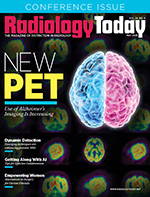 Ultrasound News: An Eye for Detail
Ultrasound News: An Eye for Detail
By Rebekah Moan
Radiology Today
Vol. 26 No. 4 P. 26
Using Optical Coherence Tomography to Better Inform Surgical Decisions
How can imaging better visualize cancer and inform surgical decisions? That’s the question Perimeter Medical Imaging AI asked—and answered—with its optical coherence tomography (OCT) technology. OCT uses light to create cross-sectional 3D images of tissue microstructures at 10 times the resolution of ultrasound and X-ray and 100 times the power of MRI.
The mechanism is similar to ultrasound, but it uses light instead of sound. OCT uses a very specific wavelength of light for tissue imaging, according to Andrew Berkeley, Perimeter Medical Imaging AI’s cofounder and chief innovation officer. For tissue imaging, the wavelength of light is centered around 1310 nanometers. Some areas of the body, such as the eye, require a different wavelength.
Traditional OCT is used on the eye, with over 30 million eye examinations performed globally every year, or in cardiovascular imaging. Perimeter Medical Imaging AI developed wide-field OCT (WF-OCT) so it can image a 10 x 10 cm piece of tissue. The light focuses down to a very distinct point, and then the surface of the tissue is rastered in three dimensions. “The light that gets reflected back, we can actually take the reflection properties and turn those properties into a signal and then into an image,” Berkeley says. For example, a microstructure with minimal density doesn’t reflect much light, so there isn’t much signal. That’s represented as a very dark pixel.
In cases of breast cancer, which often include numerous calcifications, these harder surfaces reflect a significant amount of light, which translates into a white pixel. When all of the information from OCT is constructed, a grayscale image of different pixels forms, helping radiologists and surgeons determine what is abnormal vs healthy tissue.
OCT offers high resolution, but it can only be used for a depth of about 2 mm because the light is quickly absorbed and scattered in the tissue. Sound waves travel further into the tissue, but the resolution starts to drop off as it penetrates deeper into the body. “When you want to look at very fine detail, you can only go a very shallow depth,” Berkeley says.
Perimeter Medical Imaging AI is focusing first on breast cancer and specifically using its technology to inform surgeons whether there’s a 2 mm margin of healthy tissue around a tumor, which is the standard of care. If the cancer is less than 2 mm away from healthy tissue, it’s considered a positive margin, and the patient generally has to come back for another surgery.
So far, OCT with AI is demonstrating its efficacy. In a December 2023 study published in the journal Life, the research team explored integrated wide-field OCT with an AI-driven clinical decision support system. A computationally efficient convolutional neural network-based binary classifier was developed using 585 WF-OCT margin scans from 151 subjects.
Independent testing confirmed the margins of 155 specimens, including 31 positive margins from 29 patients. The classifier achieved an area under the receiver operating characteristic curve of 0.976, a sensitivity of 0.93, and a specificity of 0.98. At the margin level, the deep learning model accurately identified 96.8% of pathology-positive margins.
In addition to breast cancer, OCT is being used in the head and neck, such as for oral cavity cancers. “There’s a big sensitivity about taking too much tissue in the oral cavity, so surgeons are always trying to spare, as you can imagine, tissue in and around the oral cavity,” he says. Sometimes, this can lead the surgeon to get very close to the tumor, but by using OCT, the surgeon can image the tumor in real time and provide guidance on the status of the margin. Positive margin implications for head and neck cancers have a significant negative impact on patient mortality rates.
“The stakes are high,” Berkeley says. “Even though there’s less volume of head and neck cancer cases, the impact of reducing positive margins is a lot greater.”
Integrating AI
OCT is essentially an imaging modality that’s being read by surgeons in the operating room, and while surgeons can read images, they don’t have the expertise of radiologists. To overcome that challenge, Perimeter Medical Imaging AI developed machine learning algorithms for OCT images so that specific areas of interest are highlighted. Instead of reading an entire stack of images, the surgeon is guided on where to look. The company recently completed a multisite trial and submitted the AI technology to the FDA for clearance.
From an imaging perspective, Perimeter Medical Imaging AI is not just using AI to classify tissue, it’s using it to help speed up image acquisition via interpolation. Instead of having to capture X amount of data, the company is cutting that in half and doing some interpolation to fill in the gaps.
“To have a really robust and very sensitive and specific AI technology for medical imaging, you need to have really good quality data, and a lot of it,” Berkeley says. “It’s very difficult to accumulate all of that data when you’re in the early stages because you don’t have broad adoption of your technology, but we’re in the process of building these datasets. So we’re also looking at ways of augmenting existing data, for example, we pick one good quality AI training label and then augment that in many different ways so that now one label turns into 10 or 15 labels.”
The company would like to exponentially grow its label sets by taking realworld data and applying augmentation to it. “It’s only ultimately going to impact patient care,” Berkeley says. “It’s not just on us, the developers. We’re trying to get the providers to be involved in partnering with us to provide data, in order for us to help the patients.”
— Rebekah Moan is a freelance journalist and ghostwriter based in Oakland, California. Her specialties are health care and profiles.
